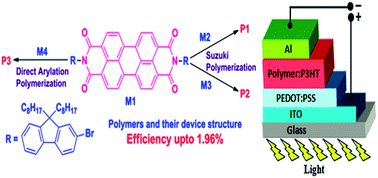Design and synthesis of N-substituted perylene diimide based low band gap polymers for organic solar cell applications†
Abstract
In this study, we report on the synthesis and device studies of a series of new copolymers containing N-substituted perylene dimide and dioctylfluorene units as part of the main backbone. A facile synthetic approach avoiding non-selective bromination was used to synthesize the monomer M1 by the reaction of perylene-3,4,9,10-tetracarboxylic dianhydride with 2-amino-7-bromo-9,9-dioctylfluorene. The copolymers P1 and P2 were synthesized by Suzuki polycondensation of M1 with 2,2′-(9,9-dioctyl-9H-fluoren-2,7-diyl)bis(4,4,5,5-tetramethyl-1,3,2-dioxaborolane) M2 and 9-(heptadecan-9-yl)-2,7-bis(4,4,5,5-tetramethyl-1,3,2-dioxaborolan-2-yl)-9H-carbazole M3, respectively. The copolymer P3 was synthesized by direct arylation polymerization of M1 with 4,7-bis(4-octylthiophen-2-yl)benzo[c]-1,2,5-thiadiazole M4. All the copolymers showed thermal stability greater than 380 °C as evidenced from thermogravimetric analysis. The copolymers exhibited a narrow optical band gap (1.80–2.08 eV) with their UV-visible absorption spectra extending up to the NIR region and they are found to be suitable for use in OSC applications. The molecular weights of the polymers P1–P3 were found to be in the range of 10.68 to 16.02 kg mol−1 as measured from GPC analysis. The surface morphology of the active layers based on P1/P2/P3:P3HT blend films was investigated by AFM and the rms values from height images range from 0.65 to 2.90 nm. The polymers were blended with P3HT to fabricate BHJ solar cells in three different weight ratios i.e. 1 : 1, 1.5 : 1 and 2 : 1 and the best power conversion efficiency was observed for the binary film of P3:P3HT blend device in a 1 : 1 weight ratio which reached up to 1.96% with a Voc of 0.55 V, Jsc of 10.12 mA cm−2 and FF of 34.63% which is among the highest reported for BHJ solar cells with N-substituted PDI based acceptors.



 Please wait while we load your content...
Please wait while we load your content...